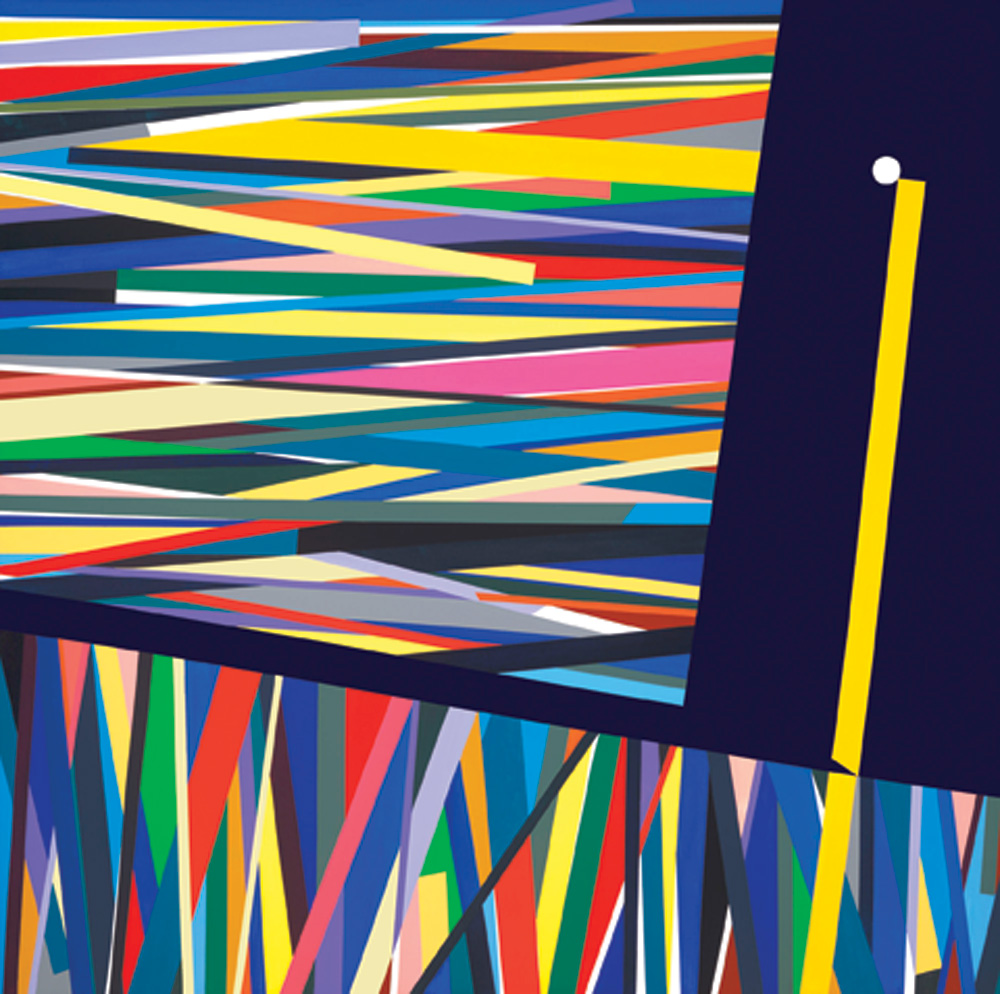« Reviews
Israel Guevara: Color + Geometry
ArtSpace/Virginia Miller Galleries - Coral Gables, Miami
By Megan Abrahams
Color! What a deep and mysterious language, the language of dreams.
Paul Gauguin
If there were a recipe for the bold, dynamic, hard-edged work of Israel Guevara, it would most likely have only two main ingredients: line and color, with the latter being the predominant flavor. Color alone can confer surprising drama on even the most reductive works of art. However, even in his reliance on limited compositional elements, Guevara succeeds in leveraging a daring approach to color, often through the strategic interplay of high-impact, energetic, interacting lines. These he manipulates and configures in a variety of unexpected ways, at times suggesting a sense of depth or implying kinetic movement. In some of his paintings, the intersecting lines create a layered effect, like ribbons of color that have been woven. In several of his works, the artist leaves large sections of white space, or areas of another color (gray, black, dark blue, yellow, etc.) as if defining a spatial shift from the adjacent, frenzied, interconnected lines in undiluted color. Suggesting depth by preserving a sense of space seems a logical component of Guevara’s work. A self-taught artist, Guevara’s approach to art making is undoubtedly informed by his former career as an architect, rooted in creating structures that occupy depth.

Israel Guevara, Sunset at San Pedro Macoris, 2017, acrylic on linen, UF, 36” x 36” x 1 ½.” Courtesy of ArtSpace/Virginia Miller Galleries, Coral Gables.
The artist branches off from the tradition of minimalists like Sol LeWitt and Frank Stella-also colorists who married dazzling palettes with line developed into complex geometric configurations. At times choosing to escape the rectangular parameters of a traditional canvas, Guevara adapts his vision onto shaped surfaces, such as parallelograms, mirrored triangles and other more complex forms, also reminiscent of Stella, as well as Tony DeLap, whose oeuvre is populated by hybrid sculptural paintings that straddle the boundary between two and three dimensions.
Even more assertive in their occupation of space are Guevara’s sculptures and assemblage constructions, which closely relate to the artist’s paintings, their surfaces carrying over the same themes of crisscrossed lines and saturated color. An air of playfulness and experimentation pervades these composite pieces. Some of them have shelves projected from the surface. Others are modular, like the series of towers composed of multicolored cubes resembling building blocks, a seemingly direct allusion to the artist’s background as an architect. In some of his works, Guevara deconstructs the continuity of traditional painting by actually breaking it apart, as in a piece painted on an assemblage of vertical blinds, so that the composition appears in strips, like one side of the shifting image on a revolving billboard.
The Venezuelan-born, Miami-based artist has devoted his artistic practice to an investigation of color, light and space. His apparent instinctive affinity for color is perfectly served by a solid foundation in geometry and structural design. Together, Guevara’s sculptural works and paintings create an engaging environment of interacting color, line and form.
(November 3, 2017 - March 31, 2018)
Megan Frances Abrahams is a Los Angeles based painter, writer and art critic who frequently publishes in WhiteHot Magazine of Contemporary Art, ARTPULSE and other publications. Abrahams is the editor of Fabrik Magazine.
Filed Under: Reviews



































Leave a Reply
You must be logged in to post a comment.